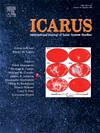测量海王星外天体的聚集和扩散程度
IF 2.5
2区 物理与天体物理
Q2 ASTRONOMY & ASTROPHYSICS
引用次数: 0
摘要
外太阳系有大量的小天体,它们所占据的轨道的动力学特征从长期稳定到快速扩散不等。本文通过对已知远地海王星外天体(TNOs)克隆的数值积分和轨道扩散的统计分析,研究了它们的混沌特性。将测量到的扩散与分析判据进行比较,可以得到动态的分离,分为稳定的、亚稳的和不稳定的物体。然后我们测量近日点经度和轨道极点的聚集程度,作为轨道距离及其稳定性的函数。由于半长轴的增加,远距离稳定的天体在近日点的ω ~ 50°附近越来越多地聚集在一起,而不稳定天体的轨道则由两个大致相等的“聚集”和“反聚集”天体群来描述,它们的均值分别在 ̄25°和 ̄205°左右。我们进一步发现,与太阳系的总角动量矢量相比,遥远的TNOs的平均轨道极对于(元)稳定的物体明显更不对齐,而对于不稳定的物体则大致保持对齐。具有中间轨道周期的TNOs也似乎与世俗理论预测的与已知行星的强迫平面不一致。这种基于稳定性的分级,如果得到即将到来的VRO调查的进一步验证,就需要一个动力学解释。本文章由计算机程序翻译,如有差异,请以英文原文为准。
Measuring the degree of clustering and diffusion of trans-Neptunian objects
The outer solar system is populated by a broad aggregate of minor bodies, which occupy orbits whose dynamical character ranges from long-term stable to rapidly diffusive. We investigate the chaotic properties of known distant trans-Neptunian objects (TNOs) by numerically integrating TNO clones and statistically analyzing their orbital diffusion. Comparing the measured diffusion with an analytical criterion yields a dynamically motivated separation into classes of stable, metastable and unstable objects. We then measure the level of clustering of the longitudes of perihelia and of the orbital poles, as functions of orbital distance and of their stability properties. Distant (meta)stable objects appear increasingly clustered in perihelion around for increasing semi-major axis, while the orbits of unstable objects are well described by two, roughly equally-populated groups of “clustered” and “anti-clustered” objects, with means around and respectively. We further find that, compared to the solar system’s total angular momentum vector, the mean orbital poles of distant TNOs are significantly more misaligned for (meta)stable objects, while they remain roughly aligned for unstable objects. TNOs with intermediate orbital periods also appear to be misaligned with respect to the forced plane predicted by secular theory with the known planets. This gradation based on stability, if validated further by the upcoming VRO survey, necessitates a dynamical explanation.
求助全文
通过发布文献求助,成功后即可免费获取论文全文。
去求助
来源期刊

Icarus
地学天文-天文与天体物理
CiteScore
6.30
自引率
18.80%
发文量
356
审稿时长
2-4 weeks
期刊介绍:
Icarus is devoted to the publication of original contributions in the field of Solar System studies. Manuscripts reporting the results of new research - observational, experimental, or theoretical - concerning the astronomy, geology, meteorology, physics, chemistry, biology, and other scientific aspects of our Solar System or extrasolar systems are welcome. The journal generally does not publish papers devoted exclusively to the Sun, the Earth, celestial mechanics, meteoritics, or astrophysics. Icarus does not publish papers that provide "improved" versions of Bode''s law, or other numerical relations, without a sound physical basis. Icarus does not publish meeting announcements or general notices. Reviews, historical papers, and manuscripts describing spacecraft instrumentation may be considered, but only with prior approval of the editor. An entire issue of the journal is occasionally devoted to a single subject, usually arising from a conference on the same topic. The language of publication is English. American or British usage is accepted, but not a mixture of these.
 求助内容:
求助内容: 应助结果提醒方式:
应助结果提醒方式:


